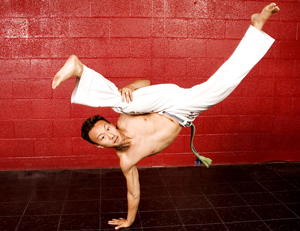
The thrilling African-Brazilian dance, capoeira (pronounced cop-wee-era), was brought to Brazil and other parts of South America by Africans transported in the trans-Atlantic slave trade.
by Raheem Todd —
The thrilling African-Brazilian dance, capoeira (pronounced cop-wee-era), was brought to Brazil and other parts of South America by Africans transported in the trans-Atlantic slave trade.
The enslaved Africans used movements from an Angolan zebra dance to mask their combat training in preparation for escape to freed-slave communities. Capoeira has made headlines as its practitioners have dispersed into other parts of the world.
Capoeira may be described as “play,” with the community of practitioners operating in a circle, referred to as the roda (pronounced hoda). The circle mimics life’s challenges and changing players. As two players at a time enter the circle, they engage in the basic movement, called ginga. Moving each foot back and forth in a crouched position, arms swinging in an alternating movement, the players feint, kick, twirl and cartwheel out of each other’s pathway.
Never intending to harm one another within the roda, their only goals are to develop greater skill, enjoy each other’s prowess and engage in the dance of life.
Now the national sport of Brazil, capoeira was an illegal practice until the 1930s, mainly because few law enforcement officials could best a skilled capoeirista. The art has become regarded as an important cultural contribution to the world as it has migrated around the globe, passing on the history, culture, songs and instrumental music integral to this martial art.
Capoeira is entertaining to witness, a joy to perform and, as ginga uses the right and left sides of the body simultaneously, it is a very effective integrator of the brain’s hemispheres. It also increases suppleness and strength and inspires people to use the same flexibility in life’s day-to-day challenges.
Raheem Todd began the study of capoeira 12 years ago in London. In his classes, he focuses on its positive effects upon health and wellness. He also teaches Hip Hop culture, history and its importance to global society. www.themedicinehome.com or 602-226-2444.
Reprinted from AzNetNews, Volume 25, Number 2, April/May 2006.





January 23, 2013
Exercise, Health, Lifestyle, Men